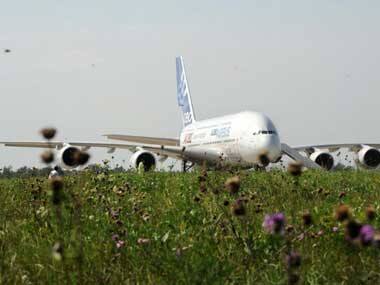New Delhi: Superjumbo A-380s could soon land in Mumbai if Civil Aviation Minister Ajit Singh gives his nod, several years after some major foreign carriers started seeking permission to use these large Airbus planes.
Issues like clogging of airport facilities like baggage handling and speedy immigration and clearance for over 500 passengers at one go were analysed and decisions to overcome them taken by a group of officials, led by civil aviation secretary KN Srivastava, ministry officials said.[caption id=“attachment_1299507” align=“alignleft” width=“380”]  Airbus A-380. AFP[/caption]
The proposal would now have to be cleared by the civil aviation minister before it can be implemented, they said.
The proposal is to start the flights of the aircraft, the world’s largest commercial jets, from Mumbai and then from Delhi, they said, adding that one more airport is being readied for the operations of these aircraft.
Several carriers like Singapore Airlines, Dubai-based Emirates and Germany’s Lufthansa, have been seeking permission to bring the aircraft into India since 2008-09, but were prevented by the prevailing rules in the country.
While the two major airports at Mumbai and Delhi are capable of handling these fully double-decker, wide-body and twin-aisled long-haul jets, the problem is the influx of over 500 passengers coming out at a time when these planes land.
The crowding at immigration, baggage clearance and customs could lead to clogging of the existing facilities which may find it difficult to handle the passengers disembarking from other aircraft that land at the same time.
Impact Shorts
More ShortsThe sources said the thinking was to allow the landings of these aircraft at a time when there are lesser number of flights operating from an airport.
Earlier, the government was maintaining that allowing the A-380 would see foreign airlines take away a large chunk of international traffic and therefore could be detrimental to the interests of Indian carriers.
A review of this decision came after the Directorate General of Civil Aviation conducting a study showed that the operations of the A-380 would not adversely affect operations of Indian carriers to and from India.
With the concerns of Indian airlines in mind, the ministry proposes to take some precautionary steps like ensuring that only airlines from those countries with which India has bilateral air services agreements (ASAs) based on the number of seats, rather than frequency of flights, are allowed to operate the A-380s.
The sources said the ASAs, which India has with a large number of countries, would have to be re-worked to include a cap on seats instead of frequencies to give effect to the decision to allow the A-380s.
The largest aircraft type mentioned in many of the ASAs are the Boeing 747s, which would also need to be changed in the ASAs, the sources said.
They said the time slots at airports having large terminals and parking space would have to be decided to enable the superjumbos to land and park.
The immigration, customs and ground handling facilities would also have to be enhanced to cater to the large number of passengers coming out of these planes.
The A-380s have already made debut flights to Delhi, Mumbai and at the airshows in Hyderabad. A few years ago, an A-380 had even made an emergency landing at Hyderabad on its way from Australia.
PTI


)

)
)
)
)
)
)
)
)



